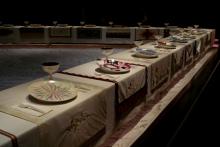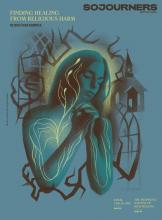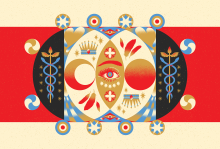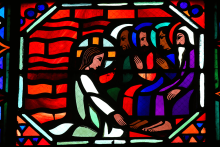Sophia

IN RATTLING THOSE DRY BONES: Women Changing the Church, activist and author Susan Cole writes an essay in response to the question, Why do I remain in the church? In her answer, she shares how she healed her relationship with God through the figure of Sophia, who she defines as “the Wisdom of God, the divine imaged as female.” Cole writes, “Through [Sophia] I have discovered in a whole new way, divine presence within myself, within my sisters, within all that is.” Cole’s portrait of a female God, filled with kindness and joy, stands in stark contrast to the millennia of androcentrism that shapes Christian teaching and practice. The treasure of the Christian female godhead remains buried, but it can be uncovered.
Sophia sits (metaphorically) at artist Judy Chicago’s “The Dinner Party,” the famed feminist installation anchored by an enormous triangular banquet table, 48 feet long on each side. From 1974 to 1979, Chicago scrupulously created unique, historically precise place settings for 39 “guests of honor,” female figures both mythical and historical, ranging from Mother Earth to Georgia O’Keeffe. An additional 999 names appear written on tiles surrounding the table. According to Brooklyn Museum curators, at Chicago’s table Sophia stands as a powerful “creative force in the universe” and a cross-cultural symbol of a female God. And the elements of Sophia’s place setting — a flower plate with watery petals and a runner made from remnants of a wedding veil — symbolize Christianity’s role in “the downfall of female power, particularly religious power.” On a grand scale, “The Dinner Party” reminds us of what patriarchy has erased.

Healing from religious harm: Why compassionate community is part of the journey.

I WAS CALLED “John the Baptist” because of that great revival movement we had down by the Jordan River. We were all so hopeful then, especially after my cousin Jesus showed up. I suspected he was The One to save our people, even after he asked me to baptize him. But when I heard that heavenly voice announcing, “This is my Son,” I knew. Judgment was coming! Jesus would know how to separate the wheat from the chaff and burn the chaff with unquenchable fire (Matthew 3:11-17)!
I was on a roll. We Jews would live by Yahweh’s law, Rome’s yoke would be cast off, and everything would change. I kept preaching and baptizing, and I even chastised Herod Antipas for his unlawful marriage (Mark 6:17-18), confident he was part of the “chaff.” Jesus was our Messiah, the Anointed One of Israel—and I had been his forerunner (Matthew 3:2-3). Yet here I am—chained to a wall in Herod’s dreary prison cell. What went wrong?
I assumed Jesus would gather and train disciples to prepare for a revolution. But rumors from my own disciples tell me this is not happening. He’s sending them out on missions to Jews, but not as I expected. They don’t even carry a backpack or a staff. Their only weapon is against physical diseases. And their promised rewards are arrests, floggings, and trials (Matthew 10:1-25). This sounds like a parody of what I was hoping for! Jesus acts more like a teacher and healer—even a prophet—but not like a king, not like an anointed Messiah!

“HAVE YOU BEEN born again?” The image of a second birth to illustrate conversion is often used by fundamentalist and conservative evangelical Christians. Yet in my experience such folks also tend to resist thinking of God as other than male. How can they overlook this very maternal activity of God’s Spirit?
Even Nicodemus gets it, at least at the physical level. In John 3, this high-ranking Jewish leader privately approaches Jesus to ask him where his charism comes from. In most familiar translations of the New Testament (such as King James and NIV), Jesus tells Nicodemus that he would understand if he were “born again” (3:3). But the Greek word anōthen is deliberately ambiguous. Jesus’ intended meaning is “born from above” (NRSV). “That which is born of the Spirit is spirit,” says Jesus in verse 6. The Holy One is our birthing mother.
When the literal-minded Nicodemus asks how a person can go back into his mother’s womb and be born again, we cannot be sure (in 3:9-10) whether Jesus gently chides or sarcastically puts him down: “Are you a teacher of Israel, and yet you do not understand these things?”
Sadly, many “teachers” throughout Christian history have not understood these things. It is now 50 years since Betty Friedan’s The Feminine Mystique opened the floodgates of second-wave feminist cultural analysis, thus preparing the ground for biblical scholars and theologians such as Letty Russell, Rosemary Radford Ruether, Elizabeth Schüssler Fiorenza, and many more. Some of us began to see that orthodox, “objective” methods of interpretation were instead often subjectively male-oriented. We began to ask, “Where is the feminine in our sacred texts? Were women there?”
I see five ways in which the gospel of John deconstructs, or at least unsettles, the rigid patterns of patriarchy in the family and society in which Jesus lived. The roles Jesus played during his life and ministry were so atypical that they color this entire narrative.